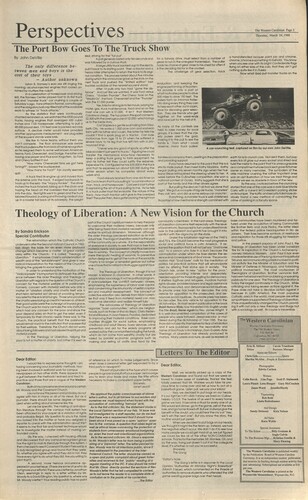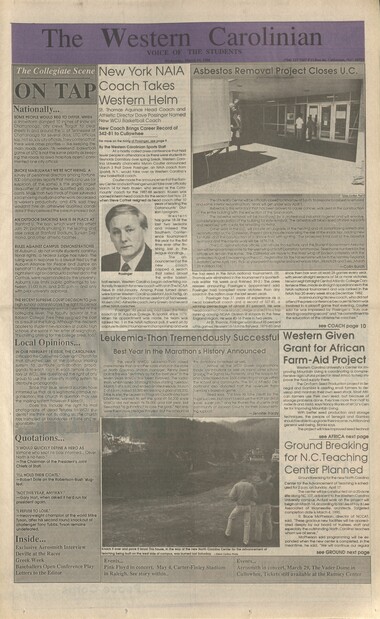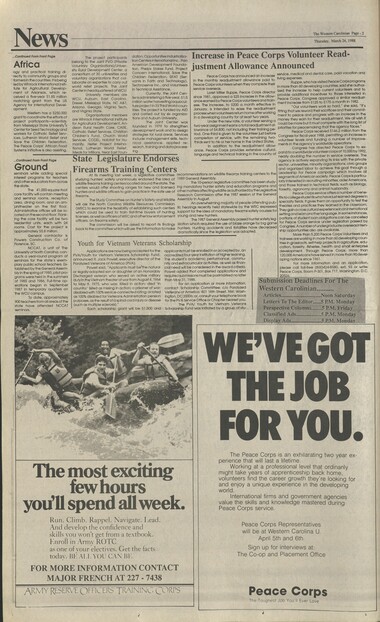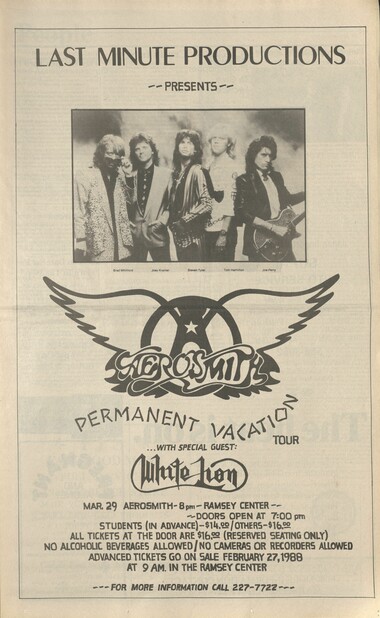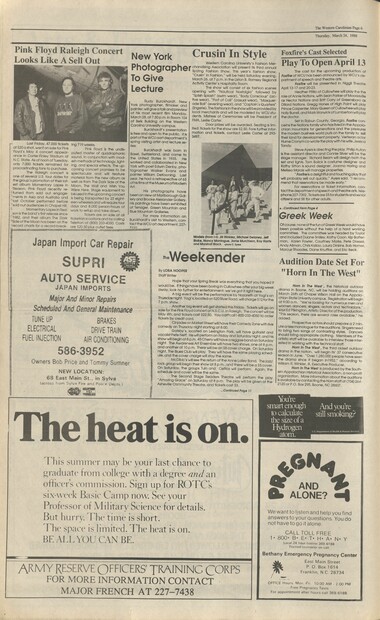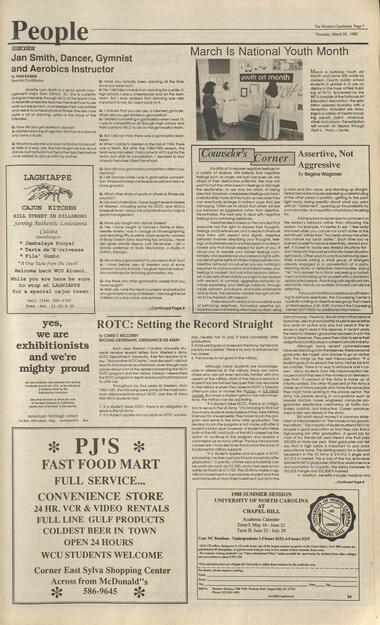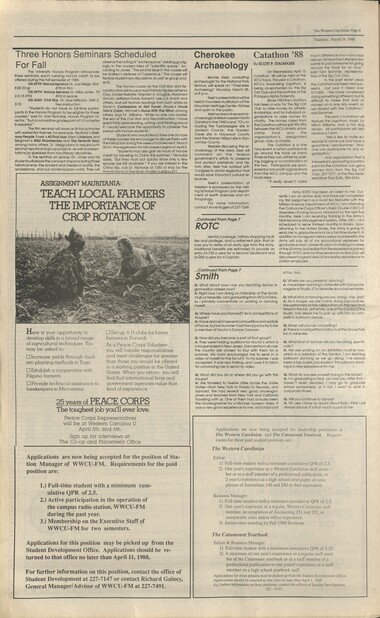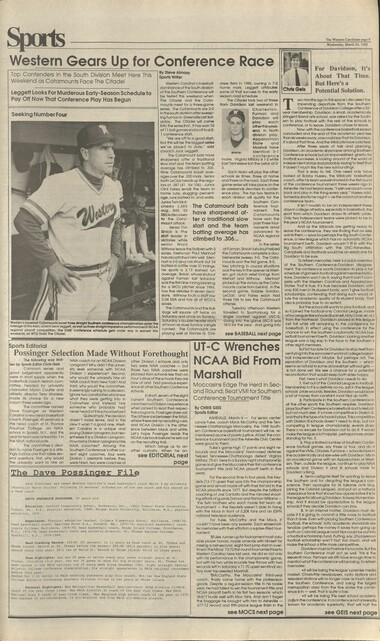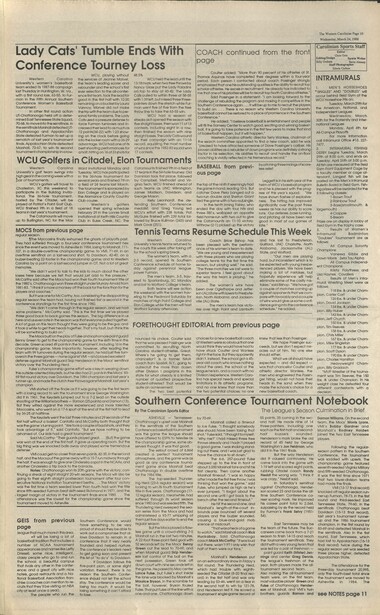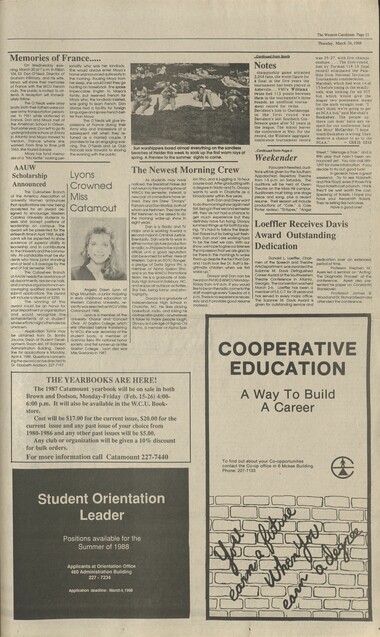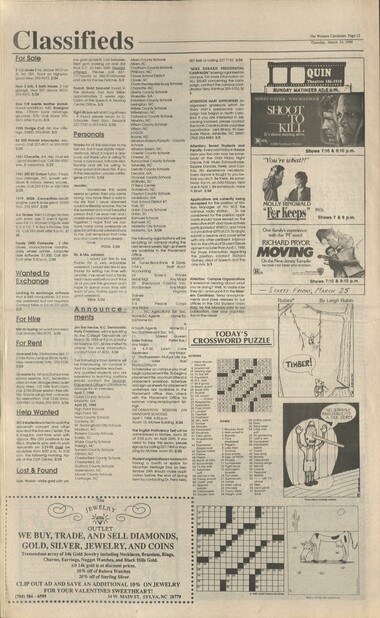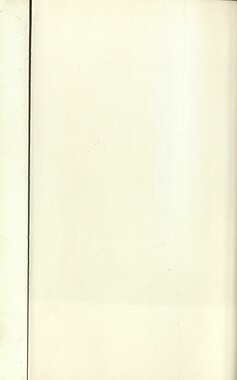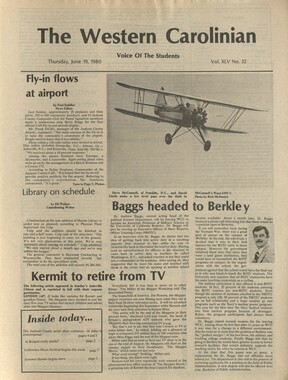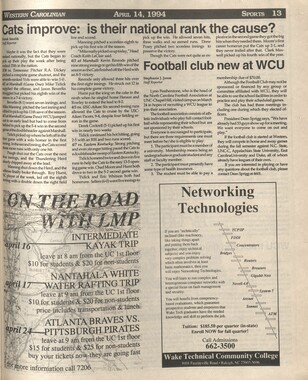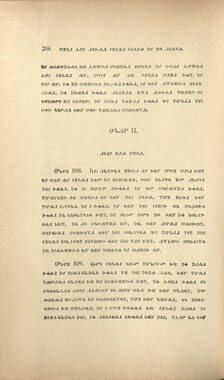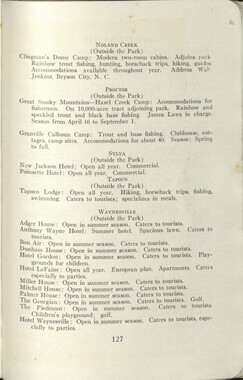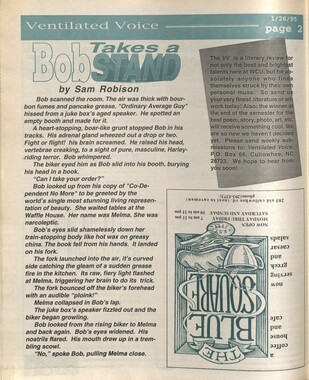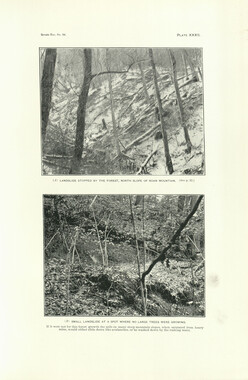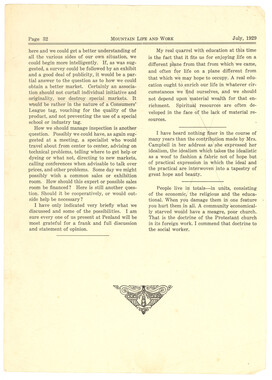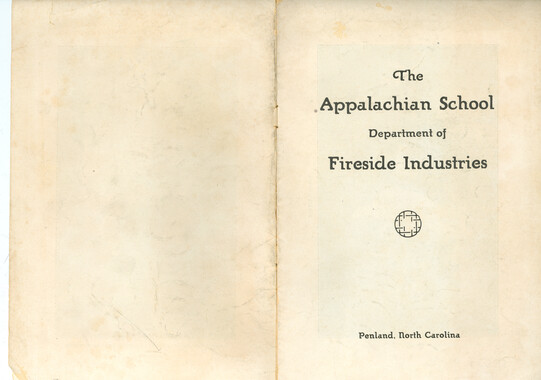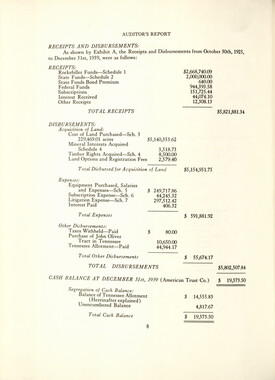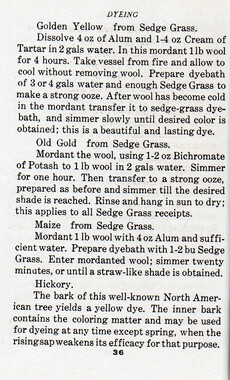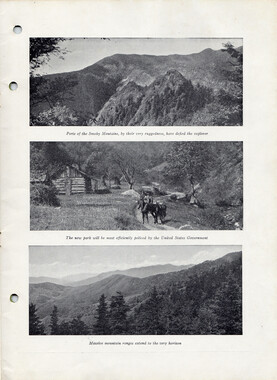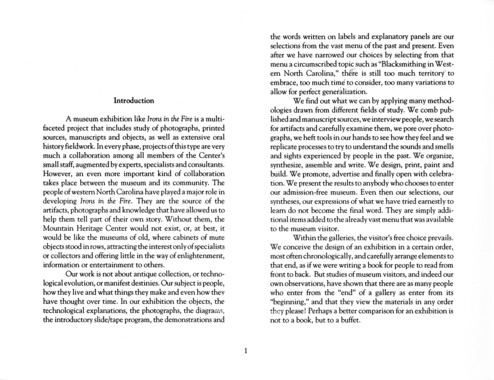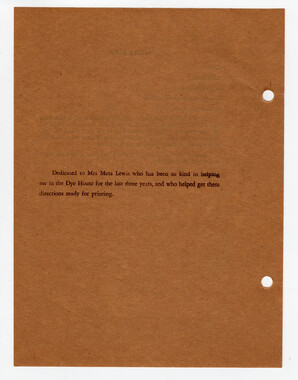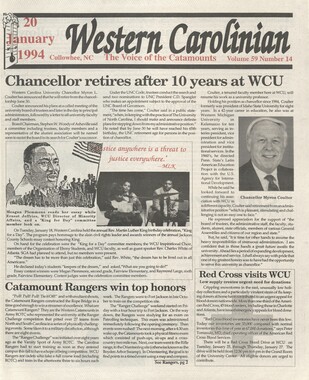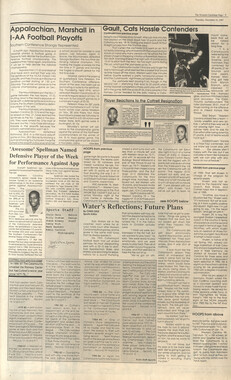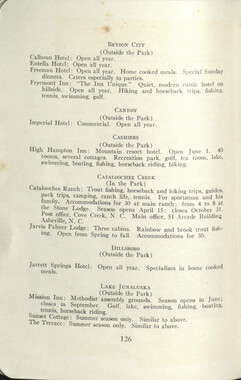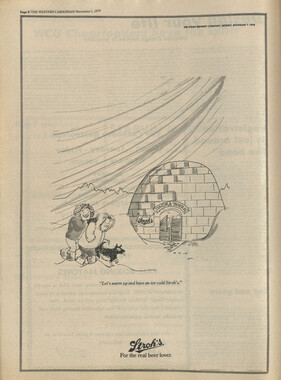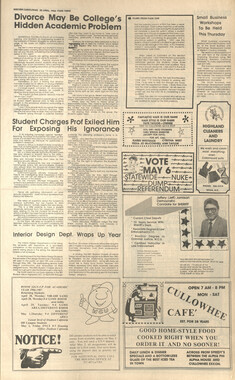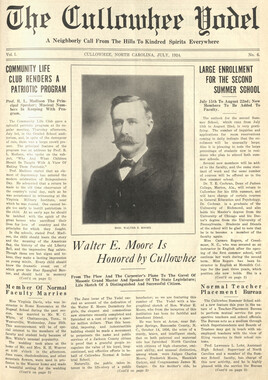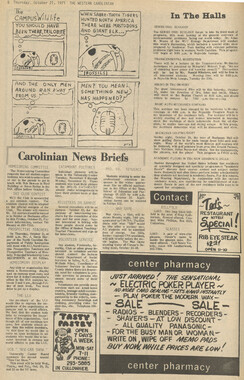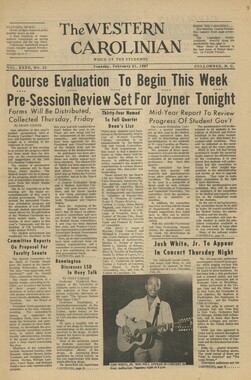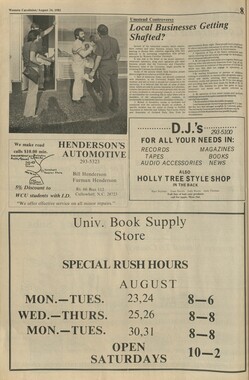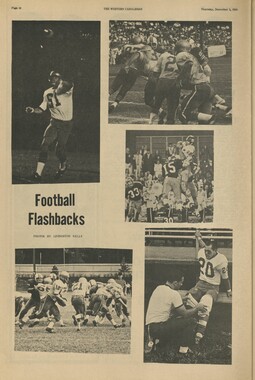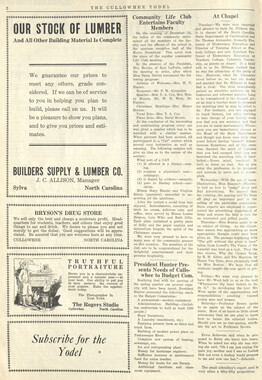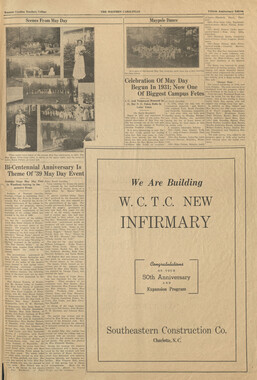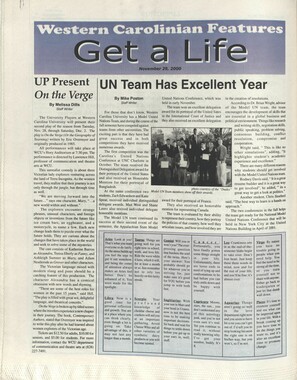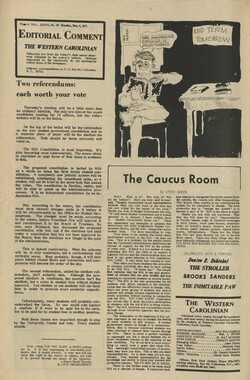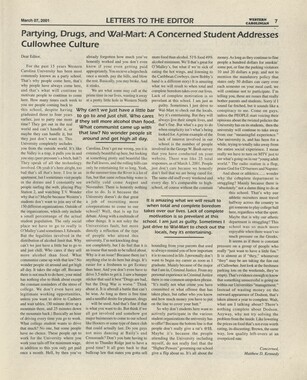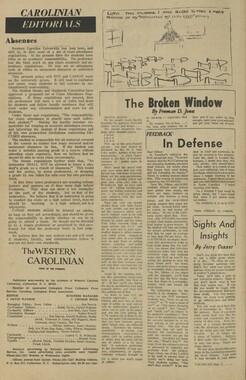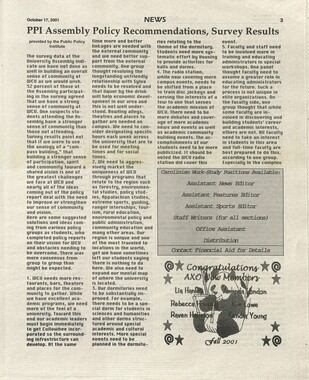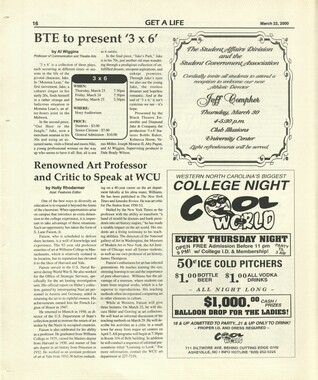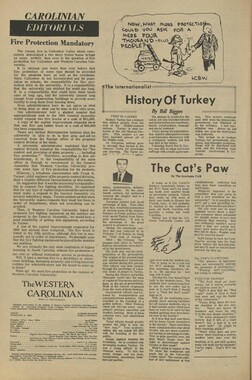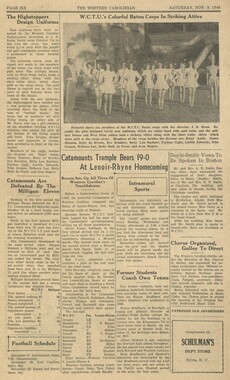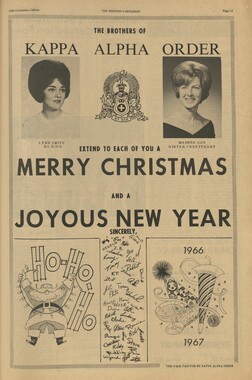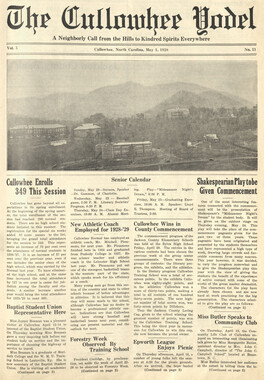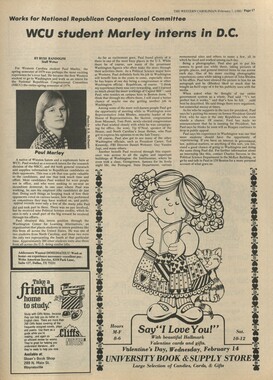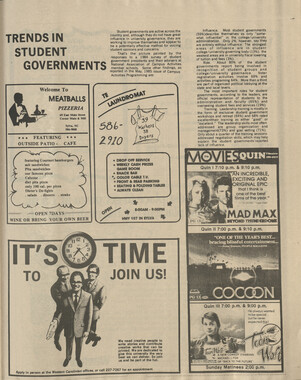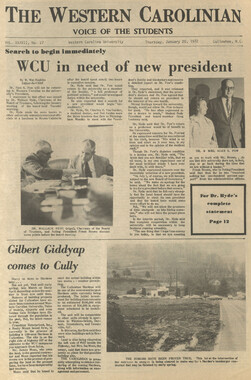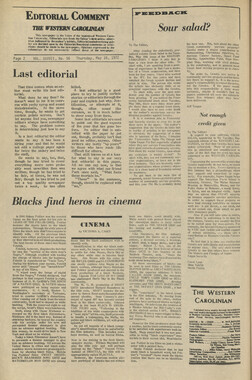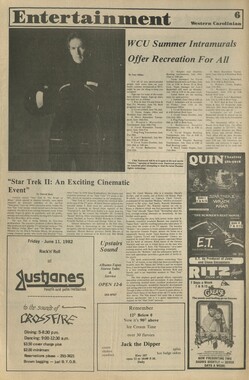Western Carolina University (20)
View all
- Canton Champion Fibre Company (2308)
- Cherokee Traditions (293)
- Civil War in Southern Appalachia (165)
- Craft Revival (1942)
- Great Smoky Mountains - A Park for America (2767)
- Highlights from Western Carolina University (430)
- Horace Kephart (941)
- Journeys Through Jackson (154)
- LGBTQIA+ Archive of Jackson County (26)
- Oral Histories of Western North Carolina (314)
- Picturing Appalachia (6772)
- Stories of Mountain Folk (413)
- Travel Western North Carolina (160)
- Western Carolina University Fine Art Museum Vitreograph Collection (129)
- Western Carolina University Herbarium (92)
- Western Carolina University: Making Memories (708)
- Western Carolina University Publications (2283)
- Western Carolina University Restricted Electronic Theses and Dissertations (146)
- Western North Carolina Regional Maps (71)
- World War II in Southern Appalachia (131)
University of North Carolina Asheville (6)
View all
- Allanstand Cottage Industries (62)
- Appalachian National Park Association (53)
- Bennett, Kelly, 1890-1974 (1388)
- Berry, Walter (76)
- Brasstown Carvers (40)
- Carver, George Washington, 1864?-1943 (26)
- Cathey, Joseph, 1803-1874 (1)
- Champion Fibre Company (233)
- Champion Paper and Fibre Company (297)
- Cherokee Indian Fair Association (16)
- Cherokee Language Program (22)
- Crowe, Amanda (40)
- Edmonston, Thomas Benton, 1842-1907 (7)
- Ensley, A. L. (Abraham Lincoln), 1865-1948 (275)
- Fromer, Irving Rhodes, 1913-1994 (70)
- George Butz (BFS 1907) (46)
- Goodrich, Frances Louisa (120)
- Grant, George Alexander, 1891-1964 (96)
- Heard, Marian Gladys (60)
- Kephart, Calvin, 1883-1969 (15)
- Kephart, Horace, 1862-1931 (313)
- Kephart, Laura, 1862-1954 (39)
- Laney, Gideon Thomas, 1889-1976 (439)
- Masa, George, 1881-1933 (61)
- McElhinney, William Julian, 1896-1953 (44)
- Niggli, Josephina, 1910-1983 (10)
- North Carolina Park Commission (105)
- Osborne, Kezia Stradley (9)
- Owens, Samuel Robert, 1918-1995 (11)
- Penland Weavers and Potters (36)
- Roberts, Vivienne (15)
- Roth, Albert, 1890-1974 (142)
- Schenck, Carl Alwin, 1868-1955 (1)
- Sherrill's Photography Studio (2565)
- Southern Highland Handicraft Guild (127)
- Southern Highlanders, Inc. (71)
- Stalcup, Jesse Bryson (46)
- Stearns, I. K. (213)
- Thompson, James Edward, 1880-1976 (226)
- United States. Indian Arts and Crafts Board (130)
- USFS (683)
- Vance, Zebulon Baird, 1830-1894 (1)
- Weaver, Zebulon, 1872-1948 (58)
- Western Carolina College (230)
- Western Carolina Teachers College (282)
- Western Carolina University (1794)
- Western Carolina University. Mountain Heritage Center (18)
- Whitman, Walt, 1819-1892 (10)
- Wilburn, Hiram Coleman, 1880-1967 (73)
- Williams, Isadora (3)
- Cain, Doreyl Ammons (0)
- Crittenden, Lorraine (0)
- Rhodes, Judy (0)
- Smith, Edward Clark (0)
- Appalachian Region, Southern (2399)
- Asheville (N.C.) (1917)
- Avery County (N.C.) (26)
- Blount County (Tenn.) (161)
- Buncombe County (N.C.) (1671)
- Cherokee County (N.C.) (283)
- Clay County (N.C.) (555)
- Graham County (N.C.) (233)
- Great Smoky Mountains National Park (N.C. and Tenn.) (510)
- Haywood County (N.C.) (3522)
- Henderson County (N.C.) (70)
- Jackson County (N.C.) (4692)
- Knox County (Tenn.) (25)
- Knoxville (Tenn.) (12)
- Lake Santeetlah (N.C.) (10)
- Macon County (N.C.) (420)
- Madison County (N.C.) (211)
- McDowell County (N.C.) (39)
- Mitchell County (N.C.) (132)
- Polk County (N.C.) (35)
- Qualla Boundary (981)
- Rutherford County (N.C.) (76)
- Swain County (N.C.) (2113)
- Transylvania County (N.C.) (247)
- Watauga County (N.C.) (12)
- Waynesville (N.C.) (73)
- Yancey County (N.C.) (72)
- Aerial Photographs (3)
- Aerial Views (60)
- Albums (books) (4)
- Articles (1)
- Artifacts (object Genre) (228)
- Bibliographies (1)
- Biography (general Genre) (2)
- Cards (information Artifacts) (38)
- Clippings (information Artifacts) (191)
- Crafts (art Genres) (622)
- Depictions (visual Works) (21)
- Design Drawings (1)
- Drawings (visual Works) (184)
- Envelopes (73)
- Facsimiles (reproductions) (1)
- Fiction (general Genre) (4)
- Financial Records (12)
- Fliers (printed Matter) (67)
- Glass Plate Negatives (381)
- Guidebooks (2)
- Internegatives (10)
- Interviews (812)
- Land Surveys (102)
- Letters (correspondence) (1013)
- Manuscripts (documents) (619)
- Maps (documents) (177)
- Memorandums (25)
- Minutes (administrative Records) (59)
- Negatives (photographs) (5835)
- Newsletters (1285)
- Newspapers (2)
- Occupation Currency (1)
- Paintings (visual Works) (1)
- Pen And Ink Drawings (1)
- Periodicals (193)
- Personal Narratives (10)
- Photographs (12976)
- Plans (maps) (1)
- Poetry (7)
- Portraits (1960)
- Postcards (329)
- Programs (documents) (151)
- Publications (documents) (2237)
- Questionnaires (65)
- Scrapbooks (282)
- Sheet Music (2)
- Slides (photographs) (402)
- Songs (musical Compositions) (2)
- Sound Recordings (796)
- Specimens (92)
- Speeches (documents) (15)
- Tintypes (photographs) (8)
- Transcripts (322)
- Video Recordings (physical Artifacts) (23)
- Vitreographs (129)
- Text Messages (0)
- A.L. Ensley Collection (275)
- Appalachian Industrial School Records (7)
- Appalachian National Park Association Records (336)
- Axley-Meroney Collection (2)
- Bayard Wootten Photograph Collection (20)
- Bethel Rural Community Organization Collection (7)
- Blumer Collection (5)
- C.W. Slagle Collection (20)
- Canton Area Historical Museum (2110)
- Carlos C. Campbell Collection (282)
- Cataloochee History Project (65)
- Cherokee Studies Collection (4)
- Daisy Dame Photograph Album (5)
- Daniel Boone VI Collection (1)
- Doris Ulmann Photograph Collection (112)
- Elizabeth H. Lasley Collection (1)
- Elizabeth Woolworth Szold Fleharty Collection (4)
- Frank Fry Collection (95)
- George Masa Collection (173)
- Gideon Laney Collection (452)
- Hazel Scarborough Collection (2)
- Hiram C. Wilburn Papers (28)
- Historic Photographs Collection (236)
- Horace Kephart Collection (861)
- Humbard Collection (33)
- Hunter and Weaver Families Collection (1)
- I. D. Blumenthal Collection (4)
- Isadora Williams Collection (4)
- Jesse Bryson Stalcup Collection (47)
- Jim Thompson Collection (224)
- John B. Battle Collection (7)
- John C. Campbell Folk School Records (80)
- John Parris Collection (6)
- Judaculla Rock project (2)
- Kelly Bennett Collection (1407)
- Love Family Papers (11)
- Major Wiley Parris Civil War Letters (3)
- Map Collection (12)
- McFee-Misemer Civil War Letters (34)
- Mountain Heritage Center Collection (4)
- Norburn - Robertson - Thomson Families Collection (44)
- Pauline Hood Collection (7)
- Pre-Guild Collection (2)
- Qualla Arts and Crafts Mutual Collection (12)
- R.A. Romanes Collection (681)
- Rosser H. Taylor Collection (1)
- Samuel Robert Owens Collection (94)
- Sara Madison Collection (144)
- Sherrill Studio Photo Collection (2558)
- Smoky Mountains Hiking Club Collection (616)
- Stories of Mountain Folk - Radio Programs (374)
- The Reporter, Western Carolina University (510)
- Venoy and Elizabeth Reed Collection (16)
- WCU Gender and Sexuality Oral History Project (32)
- WCU Mountain Heritage Center Oral Histories (25)
- WCU Oral History Collection - Mountain People, Mountain Lives (71)
- WCU Students Newspapers Collection (1744)
- Western North Carolina Tomorrow Black Oral History Project (69)
- William Williams Stringfield Collection (2)
- Zebulon Weaver Collection (109)
- African Americans (390)
- Appalachian Trail (35)
- Artisans (521)
- Cherokee art (84)
- Cherokee artists -- North Carolina (10)
- Cherokee language (21)
- Cherokee pottery (101)
- Cherokee women (208)
- Church buildings (167)
- Civilian Conservation Corps (U.S.) (110)
- College student newspapers and periodicals (1830)
- Dams (103)
- Dance (1023)
- Education (222)
- Floods (61)
- Folk music (1015)
- Forced removal, 1813-1903 (2)
- Forest conservation (220)
- Forests and forestry (1058)
- Gender nonconformity (4)
- Great Smoky Mountains National Park (N.C. and Tenn.) (181)
- Hunting (38)
- Landscape photography (10)
- Logging (103)
- Maps (84)
- Mines and mineral resources (8)
- North Carolina -- Maps (18)
- Paper industry (38)
- Postcards (255)
- Pottery (135)
- Railroad trains (71)
- Rural electrification -- North Carolina, Western (3)
- School integration -- Southern States (2)
- Segregation -- North Carolina, Western (5)
- Slavery (5)
- Sports (452)
- Storytelling (245)
- Waterfalls -- Great Smoky Mountains (N.C. and Tenn.) (66)
- Weaving -- Appalachian Region, Southern (280)
- Wood-carving -- Appalachian Region, Southern (328)
- World War, 1939-1945 (173)
Western Carolinian, March 24, 1988 (Volume 53 Number 23)
Item
Item’s are ‘child’ level descriptions to ‘parent’ objects, (e.g. one page of a whole book).
-
-
Perspectives The Port Bow Goes To The Truck Show The Western Carolinian Page 3 Thursday, March 24,1988 By John DeVille The only difference between men and boys is the cost of their toys . — Author unknown Liston B. Ramsey's ears are still ringing this morning; alcohol-injected engines that roared untamed by mufflers the culprit. In a celebration of horsepower and driving skill, the Ramsey Center played host to its first truck pull and "monster truck" car crushing a couple of Saturday's ago. Fans attired in flannel, camoflauge, and the obligatory ball cap filled half of the available seats to witness 14 "track attacks." As the statistics that were continuously chanted reminded us, we watched the 6500 pound trucks, having engines that averaged 600 cubic inches and 1100 horsepower, attempting to pull a 48,000 pound sled, 110 feet over a packed red clay surface. A decibel meter would have provided another appropriate measurement - ear plug sales at the souvenir stands were brisk. We like to have teams, without them you can't compete. The floor announcer was aware that truck pullers suffer from lack of name recognition so he assigned them to some well-known American teams: Ford, Cheverolet, and Dodge, the latter only having one player and thus soon forgotten. So Ford and Chevy battled it out. "How many Cheverolet fans we got here toningt?", blared the loudspeaker. "How many for Ford?" Fan loyalty seemed split. A truck fired its engine up and moved from the sideline onto the track. It edged backwards to hook up to the seld - the "Happy Hooker". The driver inched the truck forward, taking up In the chain and hoping the tread on the oversized tires would bite into the clay. Red lights went to green and the truck labored forward, bucking and throwing clods of clay up In a rooster tail back at its adversary, the weight sled, striving for the "full pull". A pull generally lasted only ten seconds and was followed by a curious ritual. A large utility truck backed uup to the sled to pull it back to Its starting point. Then a tractor and a heavy roller attempted to return the track to Its original condition. This process lasted about five minutes during which the announcer gave us the stats on the next truck and pushed the "limited edition" belt buckles available at the nearest souvenir stand. After 14 pulls only two had "gone the distance". And just like we wanted, it was Ford versus Chevy. "Golden Thunder", the Chevy, took on the "Madd Ox", the Ford. Cheverolet and the "Thunder" won the SI ,000 purrse. Yes, folks for driving six to ten hours, paying for motel, gas, truck maintenance, food and so on the most one can win Is SI ,000. It Isn't that Western Carolina is cheap. The top prize In this sport comes to S2,500 with the average purse at S2,000 - which brings us to the inside story. Carl Staples is a gentle soul hailing from Elizabeth City. He works a 1,000 acre corn and soybean farm with his father and cousin, the latter he tells me couldn't find a spark plug on a tractor. Carl rode motorcross from age 15 to 23 when he suffered a severe injury to his leg that has left him with a pronounced limp. "I never was any good at sports, so after the bike accident I just went to trucks." Figuring he could transfer the mechanical know-how necessary to keep a pulling truck going to farm equipment, he and his father felt they could justify the expense. Expensive It is. Carl figured he has $35,000 in the truck and that his expenses run about $20,000 during the winter season when he competes almost every week-end. I had already learned from one old-timer on the Coors team thattruck pulling is "a combination of man. track, and horsepower." Carl went a bit further in explaining the art of truck pulling to me. As he tells it. a truck puller must first evaluate the nature of the track - how much traction will It give to the oversized tires? The puller then, like a golfer picking the right iron for a fairway drive, must select from a number of gears to run In the one-gear transmission. The puller holds his choice of gear close to his chest for often It is the deciding factor In the contest. The challenge of gear selection, track evaluation, and keeping the engine performing at its potential provide Is only a part of what motivates people to drive 600 miles to drive 150 feet. The pullers form an informal fraternity doing every thing they can to help each other out In a Jam, save for disclosing gear selection. They are friends who get together on the week-ends and race Just for the hell of it. As many of the contests are held to raise money for local groups, it is clear that the miserly purses aren't the goal, making it to the pull to see the family is. From what I could observe, many truck pullers' a hand-stenclled lacquer paint job and chrome, chrome, chrome is something to behold. You know when you see one with Its bright Confederate flags flying on either side of the cab. that they ain't got nothing quite like It In Russia. New what God put monster trucks on the A car-crunching feat captured on film by our own John DeVille families accompany them, assisting In the preparation and providing support. If you have assumed to this point that this is a strictly male pursuit, then meet Kathy Maddox. Kathy began pulling only seven months ago when her husband Steve re'inquished the steering wheel to her. A week before the Cullowhee competition, she won a national contest at Ocala. Kathy suggests that she Is part of the family and the other drivers agree. But pulling the sled ain't all that we done that night. We got us a couple of big ole trucks, "monsters" they call 'em, and did us some serious car crunchin'. If anything, a monster truck is well christened. Its portayl of raw mechanical strength combined with earth for is to crunch cars. Not dent them, but pop every lick of glass out every socket and shred and twist the metal to the point that it is unrecognizable as a compartment whose back seat gave its former owner so many memories. The symbolism of the virile machine crushing the rather impotent ones was an apt illustration of how we treat things and people we see as obsolete in favor of the new. By the way, I noticed before the crunching started that one of the cars was a dark blue Monte Carlo with a current WCU-resident parking sticker on Its bumper. The traffic and security folks have obviously found a new method of combatting the crime of parking in a faculty space. Theology of Liberation: A New Vision for the Church By Sandra Erickson Special Contributor The reformation which the Catholic Church underwent after the Second Vatican Council, in 1962, laid down the basis for an even more profound change which became a matter of great controversy within the Church. It is called "Theology of Liberation." It emphasizes Christ's condemnation of wealth and of the "establishment" and gives a new radical interpretation for the mission of the Church In bringing the gospels to social reality. In order to understand the motivation of the "radical priests" it is important to distinguish the difference between the older theology and Theology of Liberation with regards to the question of the Church's concern for the material welfare of its parishioners. Formerly, concern with material welfare was only a matter of "christian charity and charity itself was a short-term remedial act aimed at providing temporary relief for the sick and hungry. Those who provided the charity were laying up credit in heaven or, at least, their good works were the outer sign of inward grace. The Church was for many centuies the only institution which had any concern for the poor and since the poor depend soley on that to get the relief, even if temporarily for their chronic needs, there was. to the Church, the practical benefit that the parishoners would remain loyal to the institution that was essential for their welfare. Therefore, the Church did not worry about losing followers and had assured its spiritual and material power. In the Theology of Liberation, helping the poor Is not a matter of charity, but rather it is seen as part of the Church's spiritual mission to help the poor to overcome their material misery, because only after being freed from material necessity can one realize his spiritual dimension. Moreover, although the older theology perceived salvation as an individual task,Theology of Liberation sees itas the work of the community as a whole. It is the responsibility of everyone in society to see that man is free from material needs and oppression and thus become free to worship. The concept of charity moves from mere theraputic healing of wounds, to preventive action designed to get at t he roots of the social ills. Charity Is no longer a remedial gesture but rather one of love that is militant in its struggle against Injustice. The Theology of Liberation, though it is not Marxist, is Marxian in character. In other words, it adopts Marx's sociology if not his political program. It acknowledges the conflict betwwen classes, emphasizing the supremecy of labor over capital, and condemning the inhumanity of selfish capital- Ism and industrial development. The concept of collective salvation also derives from Marx's premise that only if feed from material need can man overcome alienation and realize himself fully. The advocates of Theology of Liberation organize "bare communities," which are neigbor- hoods, such as those of llha do Bispo, Cristo Reden- torandBayeux, in Joan Pessoa.Paraiba,dedicated to Improving their material conditions. Base communities struggle for social justice, emphasizing childhood and adult literary, basic services, crime prevention and aid for the elderly programs all worked out by the communities including the funds, which do not come from wealthy charity but are raised by parallel economic programs such as making and selling of crafts and food by the community's members. In the rural areas. Theology of Liberation concerns itself especially with the issue of land reform. Its proposal to turn underutilized lands over to the peasant occupants has brought it into conflict with the oligarchy an the state. Under the totalitarian regimes of the 1960's and 70's, the Church became the most progressive social and political force in Latin America. It assumed the position that It will not just say "God loves you" to a person who lives in a slum because the contradiction under which he lives denies the essence and consequence of God's love. The proclamation that "God loves" calls for the mediation of politics for practical actions that will emancipate men by altering their status quo In society. The Church has, under Its new "option for the poor," orientation providing intense and desperately needed support for those strugglilng for democracy. It shelters fugitives and refugees, monitors human rights abuses, provides laywers and legal assistance to the prosecuted, and denounces social Injustices. Its private press has been for decades, the only vehicle for opposition to the prosecuted, and denounces social injustices. Its private press has been for decades, the only vehicle for opposition to the dictatorships. Its most recent publication is the book Brasll Nunca Mais, now translated Into English under the title Brazil, Never Again by Rev. James Wright. It is a well-documented compilation of the cases of people who were tortured, desaparecidos or murdered during the dictatorship of 1964-1985. The authors did not identify themselves for fear of retaliation and it was published under the reponsibiltiy and name of Sao Paulo's Archbishop, Dom Evaristo Arns. Theology of Liberation has already produced Its martyrs. Many priests and nuns, as well as leaders of base communities have been murdered and tortured under the accusation of being Communists like Brother Beto and Joas Pedro, the latter killed within the federal police headquarters in Rio de Janeiro. Their lives became symbols of resistance and inspiration for those still struggling for freedom and Justice.. In the present papacy of John Paul II, the Theology of Uberatlon has been under consstant tire for Its Inspiration In the Church's Archenemy - namely historical Marxism. John Paul II has even made extensive use of the long dormant Inquisitorial Tribunal, excommunicating priests involved in political activity like the Minister of Education and the Minister of Defense in Nicaragua, and forbidding political involvement. The most ooutspoken of Theologians of Liberation, Brother Leonardo Baff, has been twice banned from publishing or speaking publicaly for one year. The Theology of Liberation Is today the largest controversy in the Church. While criticizing and taking severe actions against It, the Pope does not take a decisive action against It because in Latin America, the most populous Catholic area in the world, most people are either sympa thizers or supportersof Theology of Uberation. It has unquestionably changed the Church, providing It with not only a new theology and liturgy but with a sociology as well. Its course is irreversible. ^Western Carolinian itiiiii'jt'^WuMeriK^ralitafm^ivOTuy:...::: :::.:.. ri:w-0S3 SfU&nt^iiferl p| ?&, Saif^/lji ::.::'•' •:-: cuiiivw^ii, Nt: &ny':y: ilijjjjjj!!!!::!^ ■•■•■-■•■■-■•■- Dear Editor: I would like to express some thoughts I am having concerning your journalistic methods. Having been involved in editorial work for campus newspapers on two other staffs, there appears to be a gulf between the methods I learned and tried to practice and those that are In vogue at the Western Carolinian. Both of my concerns revolve around a certain Mr. Woody and the Covenant Church. I do not know this person and probably do not agree with him in many or all of his views. But as a journalist, there should be some degree of fairness used when writing about someone like this. Let me be specific. The mailing of anti-abortion literature through the campus mail system has been attacked by your paper as a violation of rights and probably illegal. My question to you is this, have you looked Into the matter or have you assigned a reporter to check with the administration about this? It seems to me that fair and honest technique would be to Investigate the matter Instead of making unfounded claims. (By the way. I checked with housing officials and discovered that any campus-recognized group has the right to mail its literature through the system. I then checked to see if Covenant Student Fellowship is a duly-recognized group and found that they were. So, whether you agree with what they did or not, they have every right to do what they did. Are you willing to print that?) A second, more heinous occurrence appeared In your last issue. (There are some of us who do not Ignore your efforts!) There was a letter by Jonathan Olson, seemingly in reply to a letter written by Mr. Woody to a David Ellington. My question Is. where was Mr. Woody's letter? Your reading public has no point Letters To The Editor of reference on which to make judgements. Since when does a personal letter get responded to by a third party in newsprint? This sort of journalism is the type which causes people to ignore and stuff off your paper. I encourage you to learn your trade and make the little efforts necessary to make a competent paper better. Sincerely. Janet Leach We applaud the public consciousness of above letter's author, but In all fairness to our readers and ourselves we must respond when faced with the accusation of committing "heinous" acts. As to the first criticism: No, the statement made in the Local Opinion section of our Feb. 18 Issue was not Investigated by a staff reporter, nor do we feel that there was a requirement that It should have been since it was posed as a open "opinion" question to the campus. A question that raises legal as well as ethical Issues concerning the protection of students from unnecessary emotional badgering by even the most well-intentioned organizations. As to the second criticism: Mr. Olson's response to Mr. Woody's letter was far from being a public airing of a "personal" letter. The letter penned by Rev. Woody was for all Intentions public, since It was addressed to the president of the Inter- Fraternal Council. The letter should be viewed as a open and public complaint about greek fraternities and received Its first "public" reading at a regular meeting of the IFC. It also should be noted that Mr. Olson directly quoted the sections of Rev. Woody's letter that he felt compelled to contest, as to not leave the reader in a complete state of confusion as to the points of his contention. The Editor Dear Editor, Well, we recently picked up a copy of the Western Carolinian and found out that we were allowed to make asses of ourselves, thanks! We feel totally peeved that Mr. Wanless would take his precious time to come over and tell us how to act at a basketball game. Listen pal. we pay your salary! Yea, we decided to put bags on our heads, it's our right isn't it? I didn't know we lived on Cullow- heesky U.S.S.R. The twelve of us went to every home game we had. It became a ritual for every one of us. We would eat dinner, go to the game, yell at the refs, lose, and go home ticked off. But we'd always give the benefit of the doubt, you could hear the cry's of" Hey, we'll win the next one". But you know the story, the routine would Just persist. When we decided to put bags on our heads, we thought it might fire the team up. Instead, we had the negative effect occur. We didn't do it to see how many people we could get mad at us, we just figured we could be like all of the other NON-COMMUNIST schools. Thanks for the memories. Mr. Wanless. Oh,and by the way, trying Just doesn't cut It at the collegiate level, it's whether or not you're successful. Sincerely, The Gang 'Editor's Note: "The Gang's letter is in response to the Local Opinion,"Authorities At Monday Night's Basketball" (March 3 Issue), which commented on the threats of authorities to remove students who attended the VMI game wearing paper bags over their heads. Erin H. Millner Carole Trantham Editor Business Manager Associate Editors Chris Geis Sports Martha McAfee....People & Entertainmnet Photographer Edwin Carlton Writers Colin Burch Lisa Page Scott P. Staltnasek Laura Plumb Lora Hooper Gary McCracken Jason Ward JennlferHardy Typesetting Bob Bohl Linda Bodenhamer Ad/ Design Sandy Delmont Kirk Nelson Ad Sales Kara Wykle Special Assistants To The Editor Billy Graham & Angle Colvin To The Business Mgr Kristina Gentile & Mary Fleming The Western Carolinian is published weekly by the Publication Board of Western Carolina University. It is an independent student publication that receives its funding through student activity fees and advertising. Subscriptions are available at $16 per year. The Western Carolinian is printed at the Waynesville Mountaineer, Waynesville, N.C.
Object
Object’s are ‘parent’ level descriptions to ‘children’ items, (e.g. a book with pages).
-
The Western Carolinian is Western Carolina University's student-run newspaper. The paper was published as the Cullowhee Yodel from 1924 to 1931 before changing its name to The Western Carolinian in 1933.
-

